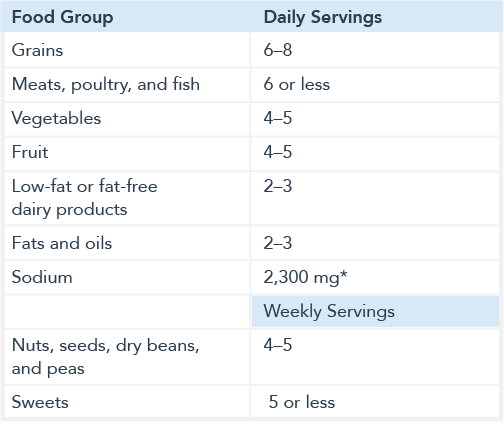Reduced-Sodium Eating
Judy Seybold, MS, RDN, LD, CLC
Chief Nutrition Officer
What you eat can affect your chances of developing high blood pressure. Scientific studies show eating less sodium can have heart-healthy benefits such as lowering blood pressure and decreasing your risk for having a heart attack and stroke.
The goal isn’t to eliminate sodium, as it is an essential mineral that’s regulated by the kidneys, but to reduce it. It helps control your body’s fluid balance, muscle contractions, and nerve impulses. Too much sodium can increase total blood volume inside your blood vessels thus increasing blood pressure. This can put a strain on your heart to work harder. Less sodium in your diet may help you lower or avoid high blood pressure.
Most people eat too much sodium. The average American eats about 3,400 mg of sodium a day. The American Heart Association recommends no more than 2,300 milligrams (1 tsp. salt) a day. Studies show eating less than 1,500 mg per day can improve blood pressure and heart health. Read labels and regularly choose products lower in sodium.
Sifter can help you find products that support a low-sodium diet. Start here→
Healthy Eating
A lifelong, healthful eating plan—Dietary Approaches to Stop Hypertension (DASH)—was developed to help people lower or control high blood pressure. This way of eating focuses on sodium reduction in the diet with the inclusion of potassium-, magnesium-, and calcium-rich foods that help lower blood pressure. Fruits, vegetables, low-fat dairy, whole grains, fish, poultry, and nuts are also recommended as mainstays of the diet. Red meat, sweets, and sugar-containing foods are limited to this eating plan.
Daily Nutrient Goals and Food Group Recommendations
In addition to lowering sodium intake, studies have indicated that these nutrient goals are also beneficial in lowering and controlling blood pressure. Choosing the right food in proper amounts can help you not only manage sodium intake, but can help manage blood pressure and weight.
- Total fat: 27% of calories
- Saturated fat: 6% of calories
- Protein: 18% of calories
- Carbohydrate: 55% of calories
- Cholesterol: 150mg
- Sodium: 2,300 mg or further improvement with 1,500 mg
- Potassium: 4,700 mg
- Calcium: 1,250 mg
- Magnesium: 500 mg
- Fiber: 30g
Daily and Weekly DASH Eating Plan Goals for a 2,000 Calorie/Day Diet from National Health, Lung, and Blood Institute

* 1,500 mg sodium lowers blood pressure even further than 2,300 mg sodium daily.
The DASH eating plan is just one component of a heart-healthy lifestyle. To help prevent and control high blood pressure in addition to following this eating plan, make sure to stay physically active, maintain a healthy weight, limit alcohol intake, and manage stress. Work with your physician to monitor high blood pressure and consult a registered dietitian to get you started with the DASH eating plan.
Additional Resources